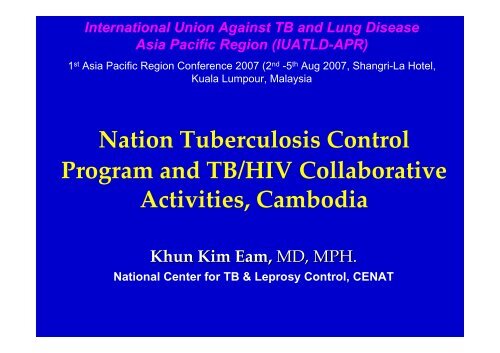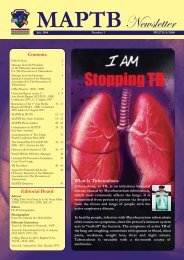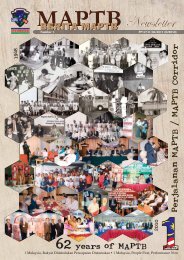download - MAPTB
download - MAPTB
download - MAPTB
You also want an ePaper? Increase the reach of your titles
YUMPU automatically turns print PDFs into web optimized ePapers that Google loves.
International Union Against TB and Lung DiseaseAsia Pacific Region (IUATLD-APR)1 st Asia Pacific Region Conference 2007 (2 nd -5 th Aug 2007, Shangri-La Hotel,Kuala Lumpour, MalaysiaNation Tuberculosis ControlProgram and TB/HIV CollaborativeActivities, CambodiaKhun Kim Eam, MD, MPH.National Center for TB & Leprosy Control, CENAT
Background•Population: 13.8 Million (2006)•Cambodia is one of the 22 high‐burden countries ofTB in the world.•TB is one of the most priority communicablediseases in the Kingdom since 1980•64% of the total population has been infected withTB.•Incidence Rate of TB all forms 510/100,000•Incidence Rate of TB SS+: 226/100,000•Death rate due to TB : 94/100,000•Prevalence HIV in TB patients (2005) : 10%
Goals and Objectives of NTP•To improve health by reducing morbidity andmortality due to TB, contributing to povertyreduction in Cambodia•During 2006‐2010:‐ TB services at all MPA Health Centers‐ Case detection rate of smear + cases: 70%‐ Cure rate of smear + cases: > 85 %•By 2015( Millennium Development Goals):‐ Reduce prevalence by 65‐70%•TB/HIV: at least 50 OD have TB/HIV services
TB Program & ServicesProgram Structures/Services:• Program Headquarters• Provincial TB Supervisors(all provinces)• OD TB Supervisors(all ODs)• TB Units : 145 ( Beds, TB laboratories)• HC with TB services : all HCs (860)+ Health posts(40)Policies, Strategy and Guidelines Development:• National Health Policies and Strategies for TB Control, 2006‐2010• National Health Strategic Plan for TB Control, 2006‐2010• Annual Operational Plan for TB control for 2006 & 2007Program Performance:• DOTS coverage at HC: 100%• Community DOTS : 40% of all HC• Cure Rate : 90 %• Case Detection Rate: 65 % ( 2006)
Trends in TB Notification (1982‐2006)TB Cases Detected, 1982-2006400003500030000No. of Cases2500020000150001000050000SM(+)SM(-)Extra-PTotal1982198419861988199019921994199619982000200220042006Year
HIV sero‐prevalence trend among TBcases12.00%11.80%10.00%8.00%7.90%6.70%10%6.00%5.20%4.00%2.50%3.90%2.00%0.00%1995 1996 1997 1999 2000 2003 2005
HIV/AIDS Situation in CambodiaFirst HIV detected in 1991 and first AIDS case diagnosed in1993In 2003: HSS’03 and BSS’03‐ Estimated HIV prevalence among adult pop. age 15‐49 is1.9% and among pregnant women at ANC is 2.1%‐ Estimated number of PLHAs among adult population:123,100 (women 57,500) and AIDS patients: ~ 25,000 including3000 childrenIn 2005: CDHS 2005‐ HIV prevalence among household pop. age 15‐49 is 0.6% andamong pregnant women is 1.1%
Principles for Collaborative efforts fordiagnosis & treatmentTB ControlProgrammeTB SuspectHIV ControlProgrammeHIV SuspectHC/TB Unit(smear/CXR)VCCT(HIV Test)No TBActive TBHIV PositiveHIV negativeTB HealthEducationDOTSTB Services :DOTSHIV/AIDS CareAIDS Services: CoCHIVPrevention
Progress & Achievement• 1999 : Sub‐Committee on TB/HIV (MoH)• 2000 : International Symposium on TB/HIV• 2001 : First TB/HIV Clinic (CENAT/JICA)• 2002 : Framework for TB/HIV in Cambodia• 2003 : ‐ 1st National HIV sero‐prevalence amongTB patients (result :12%)‐ TB/HIV Pilot Projects at 4 sites‐ CoC Framework & implementation
Progress & Achievement (Cont.)• 2004: National WS on TB/HIV Co‐morbidity• 2005: the 2 nd National HIV sero‐prevalence amongTB patients (result :10%)• 2007 (May): the 1st National TB/HIV Workshop•Development of TB/HIV Joint statement betweenCENAT and NCHADS in 2005•Provincial TB/HIV orientation WS (CENAT &NCHADS) to strengthen collaboration betweenlocal NGOs and HC staff.
Progress & Achievement (Cont.)•Joint statement by the Directors of NTP &NAP, duly endorsed by the MoH, forstrengthening treatment & care strategies ofHIV/AIDS & TB, & clarifying responsibilitiesof the two National Centres on the following:– Provision of treatment and care for TB‐HIV/AIDSco‐infection– Supply of drugs, equipment and test kits– Training of health personnel– Monitoring and evaluation of the treatment andcare for TB‐HIV/AIDS co‐infection
Progress & Achievement (Cont.)•SOP for prompt testing of TB/HIV andrapid access to treatment and care services–TB services/DOT at HC and/or FDHwith no VCCT services:Option 1TB patients receiving DOT should be supportedwith funds for transportation to the nearestVCCT site in order to have a test forHIV/AIDS.
Progress & Achievement (Cont.)Option 2HC/FDH with the capacity to provide pre‐test andpost‐test counseling and draw blood samplesfrom TB patients volunteering for HIV/AIDStesting should send specimens to the nearestVCCT .Option 3VCCT staff visit HC/FDH where TB patients havebeen group‐counseled and gathered by healthpersonnel in collaboration with HBC teams.VCCT staff will provide pre‐test‐counseling, takeblood to do rapid test at the facilities visited andprovide post‐test counseling.
Progress & Achievement (Cont.)‐ Beyond the 4 pilot sites,‐At present, 33 Operational Districts (out of77) are implementing TB/HIV activities bythe end of 2006, while 36 OD are havingCoC‐ Introduction of TB/HIV data into theexisting TB register.‐ Currently, only around 30 to 40 % of TBpatients and PLHA are referred for HIVtesting and TB screening
Recommendation to improvecollaborative TB/HIV activities(1st National TB/HIV Workshop, May 2007 )
I‐ ReferralRecommendation1. Increase financial support for referral (option1).Maintain option 1 and introduce and document theperformance of option 2 and 3.– TWG encourage partners to introduce option 2 and 32. Develop script for pre‐counseling3. Provide TB/HIV training (counseling skill)4. Increase TB/HIV education to community throughIEC materials5. Incorporate VHSG and PLHA into outreach andcounseling activities to convince TB patients for HIVtesting6. Expand HBC and VCCT
II‐ Coordination MechanismRecommendation1. Provide clear direction/guidance from National level.2. Clear assignment of TB/HIV coordinator at provincialand OD level.3. Clear description of role and responsibility of TB/HIVcoordinator.4. Regular meeting at different levels with clear content.5. Develop and implement joint TB/HIV action plan.6. Filling gap from external support for TB/HIVcollaborative activities (mobilize resources).7. Harmonize incentive scheme btw 2 programs.
III‐ Recording Reporting –M&ERecommendation1. Review existing and update TB/HIV indicators2. Joint and consistent RR system3. Improve quality of data collection (train registrar)4. Improve the capacity in data analysis and use forimproving performance at provincial and OD levels5. Improve accountability for reported data6. Joint supervision and regular feedback from Nationallevel7. Explore possibility of integrating TB/HIV RR into HIS
Key issues/Challenges•Human Resources & Capacity Building:‐ Lack of skills in HIV counseling and TB/HIV casesmanagement.‐ Staff motivation.•Referral System:– Coordination between programs still limited and limitedinvolvement of partners in general.• Data Collection (TB/HIV):– Limited skills in data collection and analysis–Data incomplete or unfilled•Development of TB/HIV IEC materials:– Lack of IEC materials for patient education & communityawareness on TB/HIV issues•Social Support to patients( transportation,..)
Plan for TB/ HIV activities• Conduct intensive training for health workers inTB/HIV including counseling to enhance treatmentadherence & follow up•Improve monitoring & surveillance system based onstandardized data collection forms/revised TBregisters•Strengthen collaboration through meeting (nationallevel, provincial and OD level).•Promote referral from both sides, especially from TBside, taking into account all barrier.•Design and disseminate appropriate IEC materials onTB/HIV to reduce discrimination in the community•3 rd round of HIV sero‐prevalence survey among TBpatients in November 2007.








